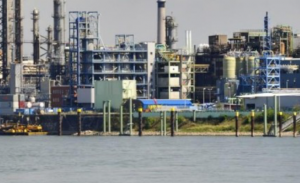
Cracker plant design needs to consider energy efficiency, GHGs, HAPs, VOCs, plastics pollution, capital cost and operating costs
From an Article by Shahrzad Pourriahi, Plastics News, August 28, 2019
Six major petrochemical companies have set up a consortium to jointly investigate how naphtha or gas steam crackers could be operated using renewable electricity instead of fossil fuels.
Chaired by the Netherlands-based Brightlands Chemelot Campus, the Cracker of the Future consortium includes BASF, Borealis, BP, LyondellBasell, Sabic and Total and aims to produce base chemicals while significantly reducing carbon emissions.
In an August 26 statement, the consortium identified steam crackers as “the principal opportunity” for reducing the industry’s greenhouse gas emissions, adding that one option currently under consideration is to electrically heat the cracking furnaces, instead of using fossil fuels.
Steam crackers produce base chemicals, including ethylene, propylene, butadiene and BTX, which are mainly transformed into plastics.
“The key challenges in developing electricity-based cracker technology are ensuring that the chosen emissions reduction solution is technologically and economically feasible compared to the current process; that it fits into a future low-carbon value chain; and that it can be implemented in time to meet policy targets,” the consortium statement noted.
Once the challenges are met, the statement added, developing and implementing electricity-based cracker technology will help the sector maintain sustainable operations while reducing the carbon footprint of its products.
The consortium partners have also agreed to invest in R&D and knowledge sharing as they assess the possibility of transitioning their base chemical production to renewable electricity.
The companies have already begun exploring and screening technical options for the cracker of the future.
“If a potential technical solution is identified, the parties will determine whether to pursue joint development project(s), including R&D activities that could include a demonstrator for proof of concept in the case of base chemicals,” the statement added.
Trilateral Strategy Under Development
The collaboration is supported by the Trilateral Strategy for the chemical industry drawn up by the North Rhine-Westphalian, Flemish and Dutch ministries of economic affairs and the industry associations VCI (Germany), Essenscia (Belgium) and VNCI (Netherlands) to boost the sustainability of the chemical sector.
The strategy aims to make the region “the world ́s engine for the transition towards a sustainable and competitive chemical industry cluster” and includes three “tables” of energy, infrastructure and innovation.
The combined trilateral region of the Netherlands, North Rhine-Westphalia and Flanders is the largest chemical cluster in the world with annual revenue of €180 billion (US$199 billion) and 350,000 jobs.
‘This is a unique collaboration that aims to reduce our industry’s carbon footprint for the betterment of society as a whole,” said Bert Kip, chair of the Trilateral Innovation Table and CEO of Brightlands Chemelot Campus.
“It demonstrates the commitment of our industry to collectively seek technological solutions to minimize greenhouse gas emissions from our operations. We are proud to have taken this first step together and look forward to the successes that lie ahead,” he concluded.
>>>>>>>>>>>>>>>>>>>>>>>>>
Dow to source pyrolysis oil feedstock made from recycled plastic waste
From an Article by Stephen Moore (K Show), Plastics Today, August 30, 2019
Dow Chemical has reached an agreement with the Fuenix Ecogy Group, based in Weert, Netherlands, for the supply of pyrolysis oil feedstock, which is made from recycled plastic waste. The feedstock will be used to produce new polymers at Dow’s production facilities at Terneuzen, Netherlands.
Fuenix Ecogy’s pyrolysis process takes a mixed plastic waste stream and converts it to a feedstock for repolymerization.
This agreement marks an important step forward to increase feedstock recycling—the process of breaking down mixed waste plastics into their original form to manufacture new virgin polymers. The polymers produced from this pyrolysis oil will be identical to products produced from traditional feedstocks, and, as such, they can be used in the same applications, including food packaging.
This agreement is an example of Dow’s strategy to enable a shift to a circular economy for plastics by focusing on resource efficiency and integrating recycled content and renewable feedstocks into its production processes. By doing so, post-consumer plastics will continue to have value through an extended lifespan. The agreement also contributes to Dow’s commitment to incorporate at least 100,000 tonnes of recycled plastics in its product offerings sold in the European Union by 2025.
“We believe plastics are too valuable to be lost as waste and should be part of the circular economy,” said Diego Donoso, Business President for Dow Packaging & Specialty Plastics. “With partners in South America, we have supported the development of construction materials made with recycled plastics for schools, and in Southeast Asia, Mexico and the United States, we have built roads made with recycled plastics. This partnership with Fuenix is an important next step in moving us closer to the future we envision, which is the sustainable production of circular polymers.”
Sirt Mellema, CEO at Fuenix commented: “This partnership offers us the opportunity to scale up our technology. Our ambition is to ensure the value of plastic waste is fully used to create new, circular plastic while significantly reducing the global use of virgin raw materials and CO2 emissions. We are excited to be working with Dow on this initiative and look forward to playing our part in helping to produce more sustainable materials.”
Dow will be showcasing its recycling portfolio at K 2019, the world’s largest plastics and rubber trade fair, from October 16 to 23 in Düsseldorf, Germany.
